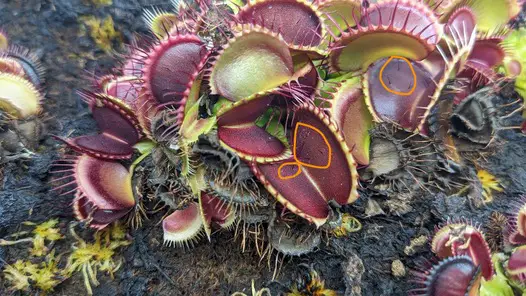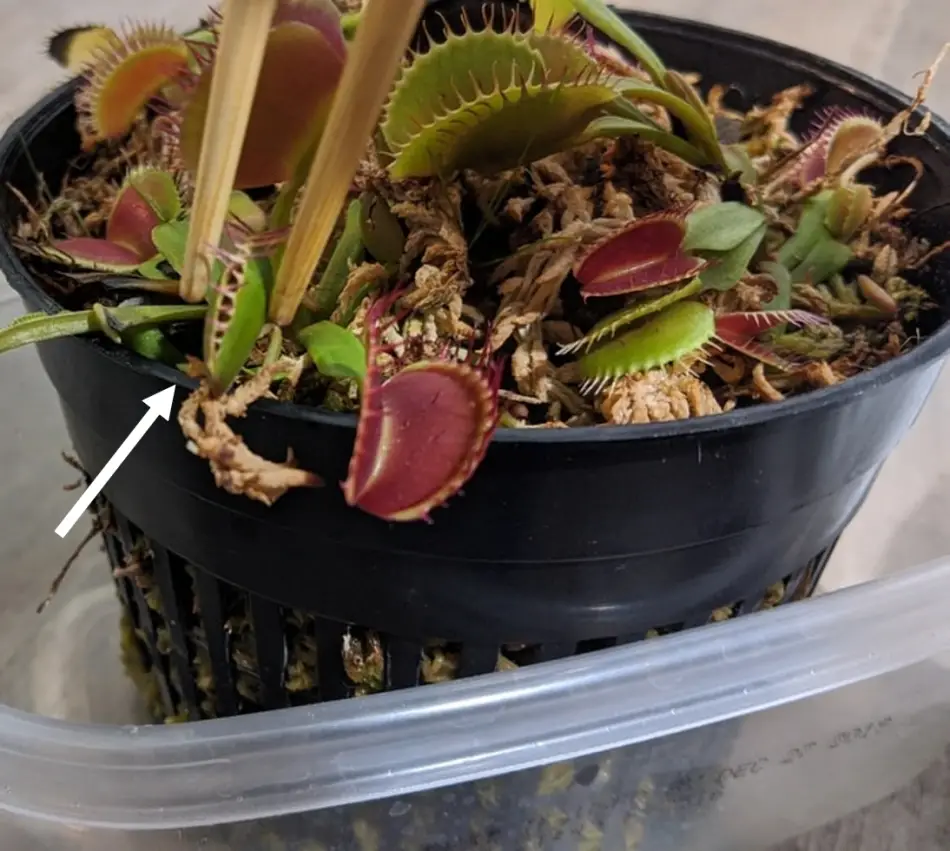Venus flytraps are carnivorous plants. They capture bugs and extract important nutrients for their wellbeing. However, feeding a Venus fly trap is often not required.
Venus fly traps can live their whole life without ever consuming an insect. The insects they capture provide nutrients that enhance the plant’s diet, but are not critical as Venus fly traps produce nutrients through photosynthesis.
If you own a Venus fly trap I would recommend feeding your plant to stimulate growth and several other benefits, but it is not a requirement. I always like to make that clear to avoid discouraging people from getting a Venus fly trap.
As a general rule, use a single insect to feed Venus fly trap once every 2 to 6 weeks. Feed a single trap and repeat once the bug is fully consumed. The portion recommendation is a bug that is no larger than 1/3 of the size of the trap.
Providing a single bug every few weeks will provide enough nutrients to stimulate growth, promote divisions and the production of flowers in the spring.
Venus flytraps do not need to be fed when grown outdoors. They are designed to capture prey and they are very effective.
So, if you grow them outdoors, feeding them manually is something you do NOT need to worry about 😉
Outdoors they will likely capture several insects a month, that is completely normal and healthy for them.
Venus fly traps will take a few weeks digesting a single insect. I recommend only feeding your plant again once it finished consuming the previous meal. Also, skip feeding during dormancy or if your plant is recovering from pests or acclimating to the environment.
Keep on reading to learn more about the best food options for your plant. Live bugs are one great options, but others are a bit more practical 😉
Signs of Overfeeding Venus flytrap
Overfeeding is usually due to feeding too often or too much. Regarding the quantity a single small insects that fits within the leaf is enough. Large insects will most likely cause dying leaves.
Technically you can feed your plant multiple bugs at the same time. However, you run the risk of losing leaves.
Sometimes when feeding leaves turn black and die. If you feed every single leaf in your plant you run the risk of killing the plant altogether. For that reason, the recommendation is to feed only one or two leaves.
Signs of UnderFeeding Venus flytrap
Venus fly traps won’t suffer if they do not capture insects. They will develop just fine. However, feeding Venus flytraps accelerates growth significantly and will promote propagation through divisions or seeds.
Best Food Options for Venus Fly Traps
You can feed your Venus fly trap with pretty much any insect or spider that is small enough to fit within a trap (this will vary greatly depending on your plant ie., baby Venus fly trap vs a mature plant).
Also, you are able to use live or dead insects for your plant. However, using dead insects requires an extra effort I will explain below in the “How to feed a Venus flytrap” section.
Here is a list of live insects you can use for feeding your plant, plus some options you can buy in pet stores or online:
Live insects
- Flies
- Crickets
- Mealworms
- Bloodworms
- Fruit flies
- Gnats
- Ants
- Spiders
- Beetles
Store bought options
- Fish pellets
- freeze dried mealworms, crickets
- Live crickets
- Live fruit flies
I buy these freeze-dried bugs in the pet store as they are very affordable, can last you for years, and are extremely nutritious. The link will take you to Amazon to review the prize, they are usually less than $10.
in the pet store as they are very affordable, can last you for years, and are extremely nutritious. The link will take you to Amazon to review the prize, they are usually less than $10.
Freeze-dried bugs are dead bugs, so you will have to follow a specific method for feeding, but it is overall very practical. There is no need to go hunting for insects at the park lol.
For a complete list of all food options and more links on where to buy them, go to this article: Best Food Options for Venus Fly Trap (complete list).
What Not to feed Your Venus Fly trap
With so much misinformation in the internet about what to feed Venus flytraps. I felt highly compelled to emphasize what you should never feed your Venus flytrap.
Please avoid using any type of human food like the following to feed your carnivorous plants:
- Hamburger
- Chicken
- Sausage
- Salami
- Raw meat
- Candy
- Fruit
- Steak
- Hotdog
- Cheese
Also, avoid feeding any animal that is not a spider or insects. Using any other animal regardless of its size will most; likely harm the plant and cause rotting. Venus fly traps are not build to consume larger animals.
How to Feed Venus Fly trap
Now, let’s get into details of how to feed a Venus flytrap. You can watch this video or follow the instructions below:
1.- Get the food ready: Start by finding a proper insect or spider. It can be dead or alive. Make sure the insects can fit inside the trap. The rule of thumb is to select an insects that is 1/3 of the size of the trap pr less.
2.- Prepare the prey: Once you have the bug, you must get it ready. Live bugs are ready to go from the start. Just make sure you are careful, they usually try to escape!
Dried-freeze insects must be rehydrated with distilled water. Just add a few drops of water to the dead bug and let it absorb the water.
3.- Select the trap you intend to feed. Tip: selecting larger and younger traps tends to be more effective.
4.- Locate the trigger hairs: Observe the inside of the trap and locate the three trigger hairs in each lobe. The filaments are thin, and are located in the center of the lobes. The picture below shows their location.

When feeding a Venus flytrap, you must touch them twice within a few seconds for them to close.
5.- Insert the bug: Grab the insect and place it inside the trap. Make sure the insect touches the trigger hairs by placing it in the center of the trap. Live insects will make contact with the trigger hairs right away, and the trap will close on them.
With dead prey, you must stimulate the trigger hairs yourself. I follow this effective strategy: grab the bug with chopsticks and place it inside the traps with a brushing motion. Touch the trigger hairs with that motion and drop the bug.
6.- Continue to stimulate: Now, the trap should have closed. If it is not closed, just touch the trigger hairs one more time.
Venus flytraps take their time to close their leaves completely and start digesting. The plant must first confirm it caught live prey.
When you employ a live insect, the bug will try to fight for its life. But, its movement inside the trap will prone the plant to close completely and start consuming it.
For dead bugs, you must complete an additional action: stimulate the leaves. Press the sides of the trap gently in a tapping motion for 30 seconds. If it does not close, continue to stimulate for another 30 seconds or until the trap is sealed shut.

After the leaf is completely closed, the plant will produce digestive enzymes and start consuming the insect.
At this stage all the work is done! Just leave your plant to consume the food. it usually take from a few days to up to 3 weeks.
For more photos and complete instruction on the feeding process, make sure to read this feeding guide . Mastering how to feed your fly trap correctly will prevent black leaves.
. Mastering how to feed your fly trap correctly will prevent black leaves.
Venus Fly Trap Care Instructions
Venus fly traps are not extremely hard to care for, but they don require some unique care. Here is a brief overview of Venus fly trap care:
- Light: Venus flytraps need exposure to plenty of light. Optimally they should receive 12 hours of sunlight, and the minimum is 6 hours of light. The light source might be natural light or artificial lighting.
- Watering: Venus flytraps must be watered only with rainwater, distilled water, and reverse osmosis water. Tap water and bottled water kill carnivorous plants. Also, the soil of the plant must always remain moist.
- Soil: Employ nutrient-free soil for carnivorous plants. Never employ enriched soil full of fertilizers. This article
 covers many soil options for Venus flytraps.
covers many soil options for Venus flytraps. - Feeding: Venus flytraps do not need to capture insects to survive, but they benefit from them greatly. This article has a complete list of what you should and shouldn’t feed a Venus fly trap.
- Suitable pots: Do not place Venus flytraps in enclosed containers. Venus flytraps prefer standard plant pots with drainage holes. Depending on the plant’s size, choose a plastic or glazed ceramic container about 2-6 inches in diameter. Also, preferably employ a tall container.
- Repotting: repot the plant once a year to avoid soil compression, fungus, and mold.
- Trimming: When leaves in a Venus flytrap dry up, they turn black. Remove them once they dry out completely.
- Fertilizers: Do not fertilize Venus flytraps. The chemicals in the fertilizers can hurt the plant.
- Temperature: Keep Venus flytraps in temperatures within this range: 32 F – 95 F (0 C – 35 C). Do not burn them in the summer, and do not let them freeze solid in the winter.
- Humidity: Venus flytraps prefer humid climates but can adapt to dry environments.
- Stress: Do not play with the traps of your plant; it causes stress for the plant.
- Dormancy: Venus flytraps must undergo a dormancy period of 2-3 months during the winter. Ensure your plant will experience this yearly resting period by placing them in a cold location.
I hope the article was helpful to you. For more information, make sure to browse around the site or visit my YouTube channel: Venus flytrap World .
.

